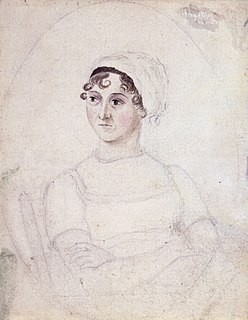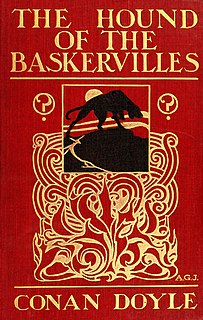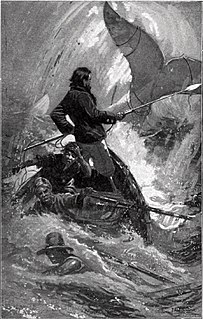
Jane Austen was an English novelist known primarily for her six major novels, which interpret, critique and comment upon the British landed gentry at the end of the 18th century. Austen's plots often explore the dependence of women on marriage in the pursuit of favourable social standing and economic security. Her works critique the novels of sensibility of the second half of the 18th century and are part of the transition to 19th-century literary realism. Her use of biting irony, along with her realism, humour, and social commentary, have long earned her acclaim among critics, scholars, and popular audiences alike.

The Hound of the Baskervilles is the third of the four crime novels written by Sir Arthur Conan Doyle featuring the detective Sherlock Holmes. Originally serialised in The Strand Magazine from August 1901 to April 1902, it is set largely on Dartmoor in Devon in England's West Country and tells the story of an attempted murder inspired by the legend of a fearsome, diabolical hound of supernatural origin. Sherlock Holmes and his companion Dr. Watson investigate the case. This was the first appearance of Holmes since his apparent death in "The Final Problem", and the success of The Hound of the Baskervilles led to the character's eventual revival.

The Picture of Dorian Gray is a Gothic and philosophical novel by Oscar Wilde, first published complete in the July 1890 issue of Lippincott's Monthly Magazine. Fearing the story was indecent, prior to publication the magazine's editor deleted roughly five hundred words without Wilde's knowledge. Despite that censorship, The Picture of Dorian Gray offended the moral sensibilities of British book reviewers, some of whom said that Oscar Wilde merited prosecution for violating the laws guarding public morality. In response, Wilde aggressively defended his novel and art in correspondence with the British press, although he personally made excisions of some of the most controversial material when revising and lengthening the story for book publication the following year.

Jane Seymour was Queen of England from 1536 to 1537 as the third wife of King Henry VIII. She succeeded Anne Boleyn as queen consort following the latter's execution in May 1536. She died of postnatal complications less than two weeks after the birth of her only child, a son who became King Edward VI. She was the only wife of the King to receive a queen's funeral, and his only consort to be buried beside him in St George's Chapel, Windsor Castle.

Catherine of Valois was the queen consort of England from 1420 until 1422. A daughter of Charles VI of France, she married Henry V of England, and gave birth to his heir Henry VI of England. Her liaison with Owen Tudor proved the springboard of that family's fortunes, eventually leading to their grandson's elevation as Henry VII of England. Catherine's older sister Isabella was queen of England from 1396 until 1399, as the child bride of Richard II.

Anne of Cleves was queen consort of England from 6 January to 9 July 1540 as the fourth wife of King Henry VIII. Not much is known about Anne before 1527, when she became betrothed to Francis, Duke of Bar, son and heir of Antoine, Duke of Lorraine, although their marriage did not proceed. In March 1539, negotiations for Anne's marriage to Henry began, as Henry believed that he needed to form a political alliance with her brother, William, who was a leader of the Protestants of western Germany, to strengthen his position against potential attacks from Catholic France and the Holy Roman Empire.

Catherine Parr, sometimes alternatively spelled Katherine, Katheryn, Kateryn or Katharine, was queen consort of England and Ireland (1543–47) as the last of the six wives of King Henry VIII, and the final queen consort of the House of Tudor. She married him on 12 July 1543, and outlived him by a year and eight months. With four husbands, she is the most-married English queen.

Elizabeth of York was the first queen consort of England of the Tudor dynasty from 18 January 1486 until her death, as the wife of Henry VII. She married Henry in 1486 after his victory at the Battle of Bosworth Field, which marked the end of the Wars of the Roses. Together, Elizabeth and Henry had seven children.

Henry Valentine Miller was an American writer and artist. He was known for breaking with existing literary forms and developing a new type of semi-autobiographical novel that blended character study, social criticism, philosophical reflection, stream of consciousness, explicit language, sex, surrealist free association, and mysticism. His most characteristic works of this kind are Tropic of Cancer, Black Spring, Tropic of Capricorn and The Rosy Crucifixion trilogy, which are based on his experiences in New York and Paris. He also wrote travel memoirs and literary criticism, and painted watercolors.

Henry James was an American author, who became a British subject in the last year of his life, regarded as a key transitional figure between literary realism and literary modernism and is considered by many to be among the greatest novelists in the English language. He was the son of Henry James Sr. and the brother of renowned philosopher and psychologist William James and diarist Alice James.

It is a 1986 horror novel by American author Stephen King. It was his 22nd book, and his 17th novel written under his own name. The story follows the experiences of seven children as they are terrorized by an evil entity that exploits the fears of its victims to disguise itself while hunting its prey. "It" primarily appears in the form of Pennywise the Dancing Clown to attract its preferred prey of young children.

Tropic of Cancer is a novel by Henry Miller that has been described as "notorious for its candid sexuality" and as responsible for the "free speech that we now take for granted in literature". It was first published in 1934 by the Obelisk Press in Paris, France, but this edition was banned in the United States. Its publication in 1961 in the U.S. by Grove Press led to obscenity trials that tested American laws on pornography in the early 1960s. In 1964, the U.S. Supreme Court declared the book non-obscene. It is regarded as an important work of 20th-century literature.

The term Great American Novel (GAN) refers to a canonical novel that is thought to embody the essence of America. It is generally regarded as being written by an American and dealing in some way with the question of America's national character. The Great American Novel is considered America's equivalent of the national epic. The term was coined by John William De Forest in a 1868 essay. Although De Forest mentioned Uncle Tom's Cabin (1852) as a possible contender, he noted that the Great American Novel had most likely not been written yet. Writer Henry James shortened the term to GAN in 1880, and it has since evolved in meaning.

The Time Traveler's Wife is the debut novel by the American author Audrey Niffenegger, published in 2003. It is a love story about Henry, a man, with a genetic disorder that causes him to time travel unpredictably, and about Clare, his wife, an artist, who has to cope with his frequent absences and dangerous experiences of reappearing in odd places. Niffenegger, who was frustrated in love when she began the novel, wrote the story as a metaphor for her failed relationships. The tale's central relationship came to Niffenegger suddenly and subsequently supplied the novel's title. The novel, which has been classified as both science fiction and romance, examines the themes of love, loss, and free will. In particular, the novel uses time travel to explore miscommunication and distance in relationships, while also investigating deeper existential questions.

Spencer's Mountain is a 1963 American family drama film written, directed, and produced by Delmer Daves from the 1961 novel of the same name by Earl Hamner Jr. The film stars Henry Fonda, Maureen O'Hara, and in early appearances in their careers, James MacArthur, Veronica Cartwright, and Victor French. Longtime Hollywood actor Donald Crisp plays "Grandpa", his final screen role.
Josephine Winslow Johnson was an American novelist, poet, and essayist. She won the Pulitzer Prize for Fiction in 1935 at age 24 for her first novel, Now in November. To this day she's the youngest person to win the Pulitzer for Fiction. Shortly thereafter, she published Winter Orchard, a collection of short stories that had previously appeared in The Atlantic Monthly, Vanity Fair, The St. Louis Review, and Hound & Horn. Of these stories, "Dark" won an O. Henry Award in 1934, and "John the Six" won an O. Henry Award third prize the following year. Johnson continued writing short stories and won three more O. Henry Awards: for "Alexander to the Park" (1942), "The Glass Pigeon" (1943), and "Night Flight" (1944).
Alison Weir is a British writer of history books, and latterly historical novels, mostly in the form of biographies about British royalty.
Horrid Henry is a British children's animated sitcom, based on the popular book series of the same name by Francesca Simon. It is produced by Novel Entertainment, broadcast from 31 October 2006 on CITV. It is now currently aired on Nicktoons, Nickelodeon and Netflix in the United Kingdom since 28 May 2018 and Toon-A-Vision and Netflix in Canada. The animation style differs from the Tony Ross illustrations in the books.

Mary Boleyn, also known as Lady Mary, was the sister of English queen consort Anne Boleyn, whose family enjoyed considerable influence during the reign of King Henry VIII.

Wolf Hall (2009) is a historical novel by English author Hilary Mantel, published by Fourth Estate, named after the Seymour family’s seat of Wolfhall or Wulfhall in Wiltshire. Set in the period from 1500 to 1535, Wolf Hall is a sympathetic fictionalised biography documenting the rapid rise to power of Thomas Cromwell in the court of Henry VIII through to the death of Sir Thomas More. The novel won both the Man Booker Prize and the National Book Critics Circle Award. In 2012, The Observer named it as one of "The 10 best historical novels".
















